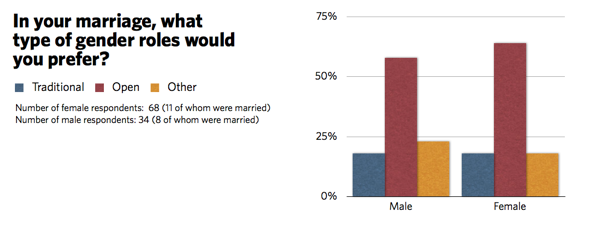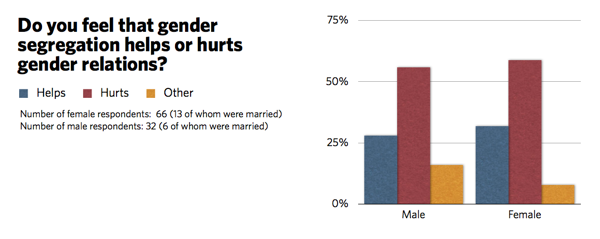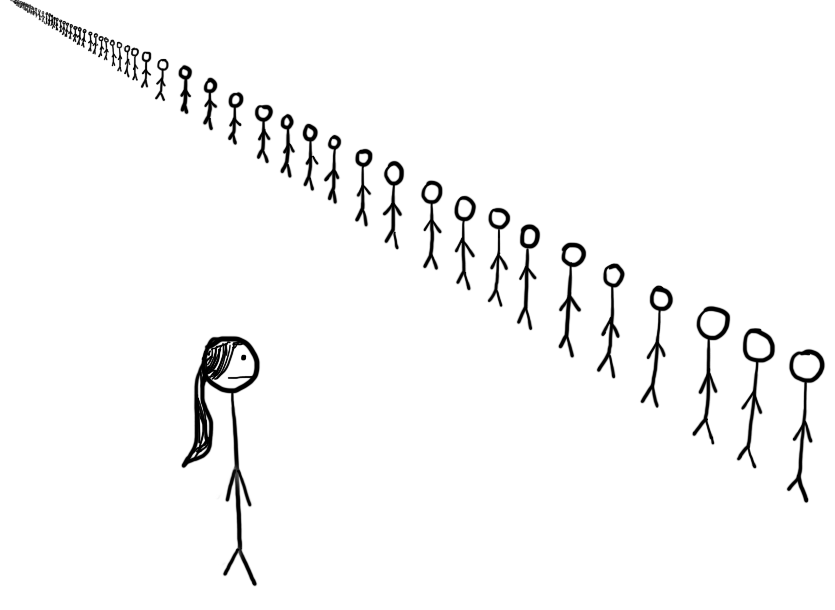With all the interest surrounding this month’s feature pieces on gender roles in marriage, Altmuslimah decided to take these issues directly to the Muslim community. Altmuslimah conducted its first poll at this past weekend’s MSA National’s East Zone Conference in Philadelphia, PA, to see how the next-in-line to-wed think.
With all the interest surrounding this month’s feature pieces on gender roles in marriage, and the commentary on gender segregation, Altmuslimah decided to take these issues directly to the Muslim community. Altmuslimah conducted its first poll at this past weekend’s MSA National’s East Zone Conference in Philadelphia, PA, to see how the next-in-line to-wed think. MSA National, the precursor to ISNA, has been around for over four decades and is committed to creating and maintaining Islamic societies on college campuses across North America. With a turn out of about 500 students at this year’s east zone conference at the University of Pennsylvania, our team collected responses from about 20% of the attendees. Conference goers representing universities from Florida through Massachusetts shared their thoughts with our team between sessions at the beautiful Penn Museum. After hearing what this mostly 18 to 25 age group had to say, we felt the conference’s theme this year, “a call to change: ambassadors in a new era,” was quite fitting. Here are the questions and what we found.
Question #1

Generally, many respondents thought deeply about the questions and pointed out the nuances, qualifying their answers before finally settling on one side or the other. “Traditional” gender roles were operationally defined using the Parson’s model (Parsons and Bales, 1955) of gender roles in the nuclear family with a total separation of male and female roles. “Open” was described as gender not being a factor in determining the division or sharing of responsibilities. Both male and female respondents were significantly more in favor of the latter option and only a small portion preferred Traditional roles. Those respondents who selected “other” were most often in favor of Open relationships but said that after kids come into the question, more traditional gender roles are better. One single female respondent said she felt Traditional gender roles allowed for a better relationship because at least one person needs to be focused on nurturing the relationship. A divorced woman said the roles should not be strictly Traditional because if the relationship falls apart, the woman needs to be in a position to support herself; as well, being somewhat independent in a marital relationship develops spiritual strength. A married man who, like his wife, is a student said if his wife ends up with a higher income than he, then he will be open to her working and him staying home when they have children. He explained, “I have to think of what’s best for our family as a whole before what’s best for me.” Across both sexes, single respondents selected Open marriage roles 12% more than the married respondents. About half of married respondents selected Open roles. A quarter of them selected “other,” which they described as more integrated roles with traditional elements.
Related research for thought
Bahira Sherif-Trask, a faculty member in the Department of Individual and Family Studies at the University of Delaware, discusses interesting and similar findings in her report, Traditional Gender Roles (2006), which examines the views and practices of the greater American population (not specific to any faith group). She points to research indicating that a majority of younger Americans believe in egalitarian roles in marriage. Sherif-Trask continues to state:
“These same studies show that many marriages today begin with an equal sharing of household and financial tasks. However, research also illustrates that traditional gender roles, specifically reflected in the division of labor in families, remain ingrained in practice and ideology. . . . According to a wide variety of studies women, especially after the birth of the first child, continue to perform most of the housework and caregiving in their families despite working outside of the home in record numbers. Men, on the other hand, continue to define their primary role as economic providers for their families. More recently this division of labor has been referred to as a “neotraditonal” arrangement wherein men perform most but not all paid work, and women perform most but not all unpaid work. This discrepancy between stated beliefs and actual practice raises many questions about how conceptualizations of gender roles intersect with work and family issues in American society.” (2006)
The report continues to explore studies on whether these divisions are a result of biological differences between the sexes or due to societal constructs.
Question #2

Many people thought this was a great and important question. For the most part, responses came quickly and were significantly opposed to gender segregation. Responses were similar across marital statuses and gender. Several female and male respondents, interestingly, felt that segregation can lead to increased promiscuity. Some pointed out the inconsistency and/or hypocrisy in the fact that in mainstream American society, the genders work with each other but then in Islamic venues find themselves segregated. Two respondents, one male and one female, expressed how accustomed they have become to the two contrasting scenes and how switching their mindset and behavior from one to the next has become second nature. Incongruity surfaces, however, when Muslim “brothers” or “sisters” cross over into their mainstream, non-Muslim scene. One married woman felt that, in the long term, segregation of the sexes helps reduce marital problems – in her case, for example, she feels uncomfortable when her husband speaks to other women. Many who responded “other” explained that in certain contexts — in mosques and during sporting activities – segregation helps, whereas in educational, professional, and social settings, it can hurt gender relations. Those who said it helps often explained that segregated settings are more Islamic, in their opinions, and create less sexual distraction.
Sources/references
- Parsons, T. & Bales, R. (1955). Family, socialization, and the interaction process. Glencoe, IL: Free Press.
- Sloan Work and Family Research Network, Boston College. (2006, August 29). Traditional Gender Roles
Discussion
Altmuslimah wants to hear from its readers:
- How would you respond to these questions? Explain.
- Do you feel these results are unique to the student population or can they be generalized to the greater American Muslim community?
- Is the large proportion of responses favoring Open, gender-neutral marriage roles just a stated ideal or do you feel they will be carried out in practice?
(Photo: huvisian via flickr under a Creative Commons license)
Shazia Riaz is associate editor of Altmuslimah.




